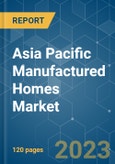Key Highlights
- The other motivating aspect will be the growing worries about green infrastructure and sustainable living to meet the needs of the expanding population. There are particular situations where the need for modular housing is more urgent. Manufactured homes can provide low-cost housing for low-income communities in Asia while safeguarding them from calamities and harsh conditions.
- The luxury market is currently presenting prefabricated homes as more than just a straightforward dwelling solution, both in the Asia Pacific and the West. High-end modular home designers are increasingly seeking inspiration outside of the West. The most lucrative market for manufactured building systems is anticipated to be Asia Pacific, and this trend is likely to stay for the foreseeable future. The market for modular homes has significantly increased over the past few years in Asia Pacific nations including China, South Korea, and India. This is giving the market for sustainable building systems a solid boost.
- Due to the rapidly rising demand from the residential sectors of India, China, and Japan, the Asia-Pacific manufactured home market is predicted to have considerable expansion over the forecast period. The Asia-Pacific manufactured homes market is expected to increase rapidly as a result of significant investments made by China and India in the development of their infrastructure.
APAC Manufactured Homes Market Trends
Investment to Support the Growth and Innovation in the Housing Sector in Australia
In Australia, there are about 40 not-for-profit organizations that have recently produced affordable homes for lower-income households and are looking to extend this service. There are eleven prominent not-for-profit developers in this category, all of whom have a strong track record and recent expansion. Leading Australian not-for-profit developers are starting to build their skills in creating a range of cost-effective, purpose-designed affordable housing options that have the consent of their tenants.All Australian governments have lately taken steps to implement financing, legislative, and regulatory methods that let not-for-profit organizations build affordable homes. Although activity levels vary between jurisdictions, governmental funding has typically not been adequate to provide a huge volume of supply or significantly increase private investment. This developing activity might be given more momentum in Australia by new Commonwealth measures, such as providing a larger financial incentive and pushing for nationally consistent regulation of the not-for-profit sector.
All Australian governments have lately taken steps to implement financing, legislative, and regulatory methods that let not-for-profit organisations build affordable homes.Although activity levels vary between jurisdictions, governmental funding has typically not been adequate to provide a huge volume of supply or significantly increase private investment. This developing activity might be given more momentum in Australia by new Commonwealth measures, such as providing a larger financial incentive and pushing for nationally consistent regulation of the not-for-profit sector.
The Australian government pledged help for the building, construction, and manufacturing industries, as well as support for the prefabricated building sector. It has announced the opening of a new collaboration lab to assist manufacturers in creating novel prefabricated buildings that are more economical and environmentally sustainable while also drastically cutting down on construction time.
The Australian government gave USD 21.27 million to PrefabAus, the industry's trade association, to improve structures and make them more affordable, effective, and secure. This programme will result in a 40% reduction in project delays, a 50% reduction in CO2 emissions, and an 80% reduction in building waste. The Australian Research Council made a sizeable investment in the ARC Training Centre for Advanced Manufacturing of Prefabricated Housing, which is run by the University of Melbourne and has received financing of USD 6 million over four years.
Japan’s prefabricated-housing industry is a world leader in innovation
In Japan, prefabricated building accounts for 15% of all new dwelling construction. Japanese families who employ prefabricated constructions frequently rebuild their homes every 30 years because they view them as depreciating, even though they are intended to endure between 50 and 100 years. While the use of prefabricated building varied by country, it has gained popularity in some markets, such as Japan, which has benefited from connections with other industrial sectors.Prefabricated dwelling units made up about the same percentage of all Japanese construction buildings over the study period-between 14% and 15%. As of 2019, Tokyo (18,683 units) had the most prefabricated buildings in Japan, followed by Kanagawa (10,864 units), Aichi (10,655 units), Chiba (8,970 units), and Saitama (8,898 units).
With effective production methods, targeted marketing strategies, consumer engagement, and high-quality designs that offer diversity and flexibility at competitive rates, Japan's manufactured home business is a global pioneer in innovation. Customers can design their homes with standardised components thanks to a completely computerised system. Contrary to popular belief in the West, factory-built homes in Japan are seen as being superior than those that are traditionally constructed.
APAC Manufactured Homes Industry Overview
There is fierce competition in the market, and only a few companies hold the lion's share. Despite market fragmentation, growth is anticipated over the coming years. Major manufactured home companies in japan are getting into the wooden housing market, including Panasonic Homes and Toyota Homes, while local power builders and construction firms are growing in influence. Major players are Daiwa House Industry, Sekisui House, Ichijo, Panasonic Homes, and Toyota Housing Corporation.Additional Benefits:
- The market estimate (ME) sheet in Excel format
- 3 months of analyst support
This product will be delivered within 2 business days.
Table of Contents
Companies Mentioned (Partial List)
A selection of companies mentioned in this report includes, but is not limited to:
- Daiwa House Industry
- Sekisui House
- Ichijo
- Panasonic Homes
- Toyota Housing Corporation
- Ausco Modular Construction
- Shanghai Star House
- Archiblox
- Anchor Homes
- Aussie Modular Solutions*








